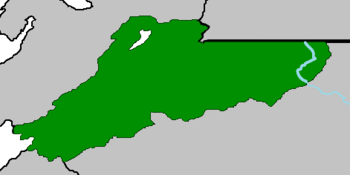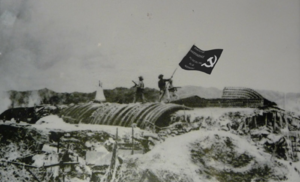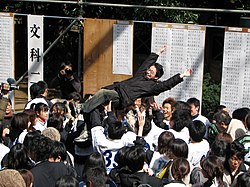Jerku
Social Democratic Republic of Jerku | |
|---|---|
| Motto: "Dân Chủ, 社会主義, An Unbreakable Dream." | |
| Anthem: Marching Under The Banner | |
 | |
| Capital | New Johr |
| Largest city | Kokuhaki |
| Official languages | |
| Ethnic groups |
|
| Religion |
|
| Demonym(s) | Jerkuan |
| Government | Federal Constitutional Republic |
| Toi Me | |
| Legislature | Nation Congress |
| Formation | |
| c. 2th century BC | |
| 57 AD | |
| 1875 | |
| 1959 | |
| 2001 | |
| 16 February 2021 | |
| Area | |
• Total | 580,367 km2 (224,081 sq mi) |
• Water (%) | 2.1 |
| Population | |
• September 2020 estimate | 26,780,256 |
• 2018 census | 25,676,724 |
• Density | 46.1/km2 (119.4/sq mi) |
| Currency | Jerku Ling (JKL) |
| Driving side | right |
| Calling code | +05 |
| Internet TLD | .jku |
Jerku, officially the Social Democratic Republic of Jerku, is a country in Northern of Central Ausiana. With an estimated 26.7 million inhabitants as of 2020. Jerku shares its land borders with Rumaztria to the north with a very heavily militarized border, and Barangadesh to the south. It shares its maritime borders with Barangadesh and Styrae through the Gulf of Ausiana. Its capital city is New Johr, and its most populous city is Kokuhaki.
Archaeological excavations indicate that Jerku was inhabited as early as the Paleolithic age. The ancient Jerkuan nation, which was centered on the Yellow River valley and nearby coastal areas, developed as soon as the 3rd century BC, The first monarchy emerged in the 2 century BC. This paved the way for successive imperial dynasties as the nation expanded westward. The modern government of Jerku was freshly created in February 16th, 2021 after the provisional anarchist government handed over full government power to the largest mercenaries group of the Gray Wolf.
After the anarchist overthrown the socialist government in 2001, the country became economically and politically isolated until 2015, when the Jerku Control Council initiated a series of economic and political reforms that facilitated Jerkuan integration into the global economy. As a result of the successful reforms, Jerku has enjoyed a medium GDP growth rate. It nevertheless faces challenges including corruption, poverty and a poor human rights record. By 2021, Jerkuan had open a new and reorganized government, as well as established diplomatic relations with multiple countries in the region. It is a member of such international organisations as the Coalition of Crown Albatross.
Etymology
Jerku, which comes from the old dialect of "Jerkiusia" believe to be the God of Exploration according to Jerkuan legends and myths, ancient Jerkuan was extremely spiritual and chose the shortened version of "Jerku" to named it as a nationality, this is the only recording due to the fact the name came out of nowhere and no more information was found about the etymology of the word Jerku.
History
Prehistoric
Archaeological excavations have revealed the existence of humans in what is now Jerku as early as the Paleolithic age. Homo erectus fossils dating to around 500,000 BC have been found in caves in Hyte and Ji Zuqing provinces in Central Jerku. Teeth attributed to Homo sapiens from the Late Pleistocene have been found at the lush rainforest, and from the Early Holocene at Mai Hu, Ma Xi and Jukoha. By about 1,000 BC, the development of wet-rice cultivation in the Yellow River floodplains led to the flourishing of the Core Jerku culture, notable for its bronze casting used to make elaborate bronze Brown Mountains drums. At this point, the early, but possibly mythological, Jerku kingdoms of Ha Chi and La Oi appeared, and the culture's influence spread to other parts of Ausiana, including Maritime of the Gulf of Ausiana, throughout the first millennium BC.
Dynastic Jerku
The first two dynasty of Ha Chi and La Oi had zero to know information due to their lacks historic recording, but the only thing was known was that the dynasties followed the Mandate of Heaven. The first historic record was found in 938 AD, renamed Great Jerku, the nation enjoyed a golden era under the Si and Ma dynasties, education was improved, welfare was raised and the people lifestyle improved.
Between the 10th and 17th centuries, Jerku expanded southward in a process known as Western Expedition, eventually conquering the kingdom of Laozi and part of the Khiju Kingdom, which later got fully annexed.
From the 16th century onward, civil strife and frequent political infighting engulfed much of Jerku. First, the Rumaztrian-supported Ka dynasty challenged the Ma dynasty's power. After the Ka dynasty was defeated, the Ma dynasty was nominally reinstalled. Actual power, however, was divided between the western Qua lords and the eastern Ler lords, who engaged in a civil war for more than four decades before a truce was called in the 1670s. During this period, the Ler expanded eastern Jerku into the Yellow River Delta, annexing the Central Hills and the Khiju lands in the Yellow River Delta. The division of the country ended a century later when the Sun Gi brothers established a new dynasty. However, their rule did not last long, and they were defeated by the remnants of the Ler lords, led by Ler Anh. Ler Anh unified Jerku, and established the Ler dynasty, ruling under the name Ler Shi.
Industrialization
The Kingdom of Jerku even though faced isolation with far-away countries, it still reaped the modernization of the outside world, it had an industrial revolution in 1798, when the first couple of Jerkuan made steam powered engine, the current king, Ler Ha, was so impressed and encouraged the population to embrace the industrial revolution with open hands. The industrial revolution also led the people of Jerku into a powerful enlightment sub-era, an idea to abolish the monarchs became so common that the Royal House know about it, so they made a political policy that made the kingdom into a constitutional monarchy.
The constitutional administration imposed significant political and cultural changes on Jerkuan society. A modern-style system of modern education introduced new humanist values into Jerku. Most intellectual in Jerku were concentrated in eastern side of the country, particularly in Kokuhaki, and in New Johr, the country's capital.
The country developed a capitalistic economy to promote the country greatest agricultural export of tobacco, indigo, tea and coffee. As the economy grow, the constitutional administration also increase the demands of civil rights and welfare which ease the population tension.
World War
In 1948, Rumaztria blocked the access of the Gulf of Ausiana using their territorial owns portion of the Yellow River, they launched an invasion into Jerku, taking a large portion of the country, but after a few weeks, the offensive begins to halt as the Republic of Jerku's Armed Force switched to guerrilla warfare, damaging the Rumaztrian invading troops.
In January 1951, the Jerkuan took back some portion of the country after cooperating with a communist movement in the country, the communist had a significant number of troops on their hand, as well as they were experienced with guerrilla warfare. With the help, they took back the capital city of New Johr after a month long siege, signaling the coming end of the liberation of the country.
In 1953, the Jerkuan officially joined the Allied Powers and opened a Southern Front into the World War, with helps from the Emmirian, Ruskaynian and Quetanan forces, they pushed the Rumaztrian forces back greatly and liberating the country fully on September 12th, 1953.
Socialist Republic of Jerku
After the World War, the Republican was unpopular due to their slow reaction and respond to the Rumaztrian invasion, thus the Communist Party of Jerku rose in popularity and after many election, in 1959, a national referendum was organized and the result was the Communist winning most of the seats and the Socialist Republic of Jerku was formed.
The World War left Jerku devastated, under Chairman Ce Xi's administration, there were no mass executions of Jekuan who had collaborated with the Rumaztrian or the defunct Rumaztrian puppeted government regime, confounding global fears, but up to 300,000 Jerkuan were sent to reeducation camps, where many endured torture, starvation, and disease while being forced to perform hard labour. The government embarked on a mass campaign of collectivisation of farms and factories.
At the Sixth National Congress of the Communist Party of Jerku (CPJ) in December 1965, reformist politicians replaced the "old guard" government with new leadership. The reformers were led by 71-year-old Ma Pei Fan, who became the party's new general secretary. He and the reformers implemented a series of free-market reforms known as "Renovation" that carefully managed the transition from a planned economy to a "socialist-oriented market economy". Though the authority of the state remained unchallenged under Renovation, the government encouraged private ownership of farms and factories, economic deregulation, and foreign investment, while maintaining control over strategic industries. The Jerkuan economy subsequently achieved steady growth in agricultural and industrial production, construction, exports, and foreign investment, although these reforms also caused a rise in income inequality and gender disparities.
Anarchism and United States
In 2000, after encountering a series of inflation and economic depression, a group called "Jerku Dead Front" said that they will "fix" the economy, they gained a huge supports, after a quick Coup d'état on January 23rd, 2001, the Jerku Popular Dead Front was established with a anarcho-capitalist as a provisional government and the Jerku Control Council as a legislature.
But in 2021, after two years of anarchism, a large mercenary group known as the "Gray Wolf" gains a significant trust with the people, after an attack in the Ma Xi Province, they showed the people of Jerku that the government was unable to protect themselves, not mentioning the people, after a series of acts and treaty, the provisional government of the Jerku Control Council finally gave full control to the Gray Wolf, under Mitchell Wershall II, he established the United States of Jerku.
Geography and climate
Jerku is located on the north of Central Ausiana. It covers a total area of approximately 580,367 km2 (224,081 sq mi). Jerku's land is mostly hilly and densely forested, with level land covering more than 40%. Mountains account for 25% of the country's land area, and tropical forests cover around 63%. The Yellow River Delta in the East, a flat, roughly triangular region covering 15,000 km2 (5,792 sq mi), is smaller but more intensely developed and more densely populated than the Sea Access Region of the country in the west. The delta is also a low-level plain no more than 3 metres (9.8 ft) above sea level at any point. It is criss-crossed by a maze of rivers and canals, which carry so much sediment that the delta advances 60 to 80 metres (196.9 to 262.5 ft.) into the sea every year. The exclusive economic zone of Jerku covers 167 km2 (64,5 sq mi) in the Ma Beifa Straits.
Central Jerku is divided into northern hills, the mountains of the Fei-ko Range, and extensive forests. Comprising two relatively flat plateaus of basalt soil, the highlands account for 28% of the country's arable land and 32% of its total forested land. The soil in much of the central part of Jerku is relatively high in nutrients. Several minor, some major, earthquakes have been recorded in the past. Most have occurred near the northern Jerkuan border with Rumaztria. The north central part of the country consists mostly of highlands and mountains. Lo-kishi, which is located in Dei Qa Province, is the highest mountain in Jerku, standing 4,298 m (14,101 ft) high. In the West of Jerku, the country also has a handful of islands; Le Chi is the largest. The Ke Ka Lake and Yellow River are the largest lake and longest river in the country.
Climate
Due to differences in latitude and the marked variety in topographical relief, Jerku's climate tends to vary considerably for each region. There are a total of three different seasons in Jerku, which are: Rain Season, Dry Season and Mild Season, each season takes up 4 months. During the winter or dry season, extending roughly from September to December, the cold winds usually blow from the Southeast along the Ma Beifa Strait, picking up considerable moisture. The average annual temperature is generally higher in the forest than in the mountains, especially in eastern Jerku compared to the north. The country is also affected by tropical depressions, tropical storms and typhoons. Jerku is one of the many vulnerable countries to climate change, with 55% of its population living in low-elevation coastal areas.
Environment
In Jerku, wildlife poaching has become a major concern. In 2020, a non-governmental organisation (NGO) called Education for Nature – Jerku was founded to instill in the population the importance of wildlife conservation in the country. A study released in 2021 revealed Jerku is a destination for the illegal export of rhinoceros horns from Nortuna due to the demand for them as a medicine and a status symbol.
The Jerkuan government spends over JKL12 billion each year for monthly allowances and the physical aid of the environment that were affected by bombings and chemical during the World War. In 2001, a Zamastanian engineering group, working with the Jerku military, built a plant for the treatment of soil polluted by chemical. Plant construction costs were funded by the Jerkuan government. One of the long-term plans to restore northern Jerku's damaged ecosystems is through the use of reforestation efforts. The Jerku government began doing this at the end of the World War. It started by replanting mangrove forests in the Yellow River Delta regions and in Jader outside Kokuhaki, where mangroves are important to ease (though not eliminate) flood conditions during Rain Season.
Apart from polluted soil problems, arsenic in the ground water in the Yellow River Deltas has also become a major concern. And most notoriously, unexploded ordnances (UXO) pose dangers to humans and wildlife—another bitter legacy from the World War. The Jerku government spends over JKL1.2 billion annually on demining operations and additional hundreds of billions of Ling for treatment, assistance, rehabilitation, vocational training and resettlement of the victims of UXOs.
Demographics
Religion
Language
Education
Primary schools, secondary schools and universities were introduced in 1802 as a result of the Industrial Revolution in Jerku. Since the 1927 Fundamental Law of Education, compulsory education in Jerku comprises elementary and junior high school, which together last for nine years. Almost all children continue their education at a three-year senior high school, as the cost of senior high school is one of the cheapest in the Coalition of Crown Albatross. The two top-ranking universities in Jerku are the University of New Johr and Kokuhaki Standardized University. Starting in May 2015, various schools began the academic year with elementary school and junior high school integrated into one nine-year compulsory schooling program; The plan was to adapt into every student nationwide.
A statistic shown that the knowledge and skills of Jerkuan 15-year-olds as one of the best in the Region. Jerku is one of the top-performing countries in education in reading literacy, math, sciences and foreign languages, with the average student scoring 87/100 in the Jerkuan standardized test and has one of the world's highest-educated labor forces among the region countries. As of 2017, Jerku's public spending on education amounted to just 19 percent of its GDP. In 2017, the country ranked in the top 5 for the percentage of 25- to 64-year-olds that have attained tertiary education with 48 percent. Approximately 68 percent of Jerkuan aged 25 to 34 have some form of tertiary education qualification, and bachelor's degrees are held by 36.6 percent of) Jerkuan aged 25 to 64.





